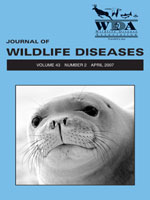West Nile virus (WNV) has affected many thousands of birds since it was first detected in North America in 1999, but the overall impact on wild bird populations is unknown. In mid-August 2002, wildlife rehabilitators and local wildlife officials from multiple states began reporting increasing numbers of sick and dying raptors, mostly red-tailed hawks (Buteo jamaicensis) and great horned owls (Bubo virginianus). Commonly reported clinical signs were nonspecific and included emaciation, lethargy, weakness, inability to perch, fly or stand, and nonresponse to danger. Raptor carcasses from 12 states were received, and diagnostic evaluation of 56 raptors implicated WNV infection in 40 (71%) of these cases. Histologically, nonsuppurative encephalitis and myocarditis were the salient lesions (79% and 61%, respectively). Other causes of death included lead poisoning, trauma, aspergillosis, and Salmonella spp. and Clostridium spp. infections. The reason(s) for the reported increase in raptor mortality due to WNV in 2002 compared with the previous WNV seasons is unclear, and a better understanding of the epizootiology and pathogenesis of the virus in raptor populations is needed.
How to translate text using browser tools
1 April 2007
RAPTOR MORTALITY DUE TO WEST NILE VIRUS IN THE UNITED STATES, 2002
Emi K. Saito,
Louis Sileo,
D. Earl Green,
Carol U. Meteyer,
Grace S. McLaughlin,
Kathryn A. Converse,
Douglas E. Docherty

Journal of Wildlife Diseases
Vol. 43 • No. 2
April 2007
Vol. 43 • No. 2
April 2007
avian disease
avian viral infection
histopathology
raptor mortality
West Nile virus




